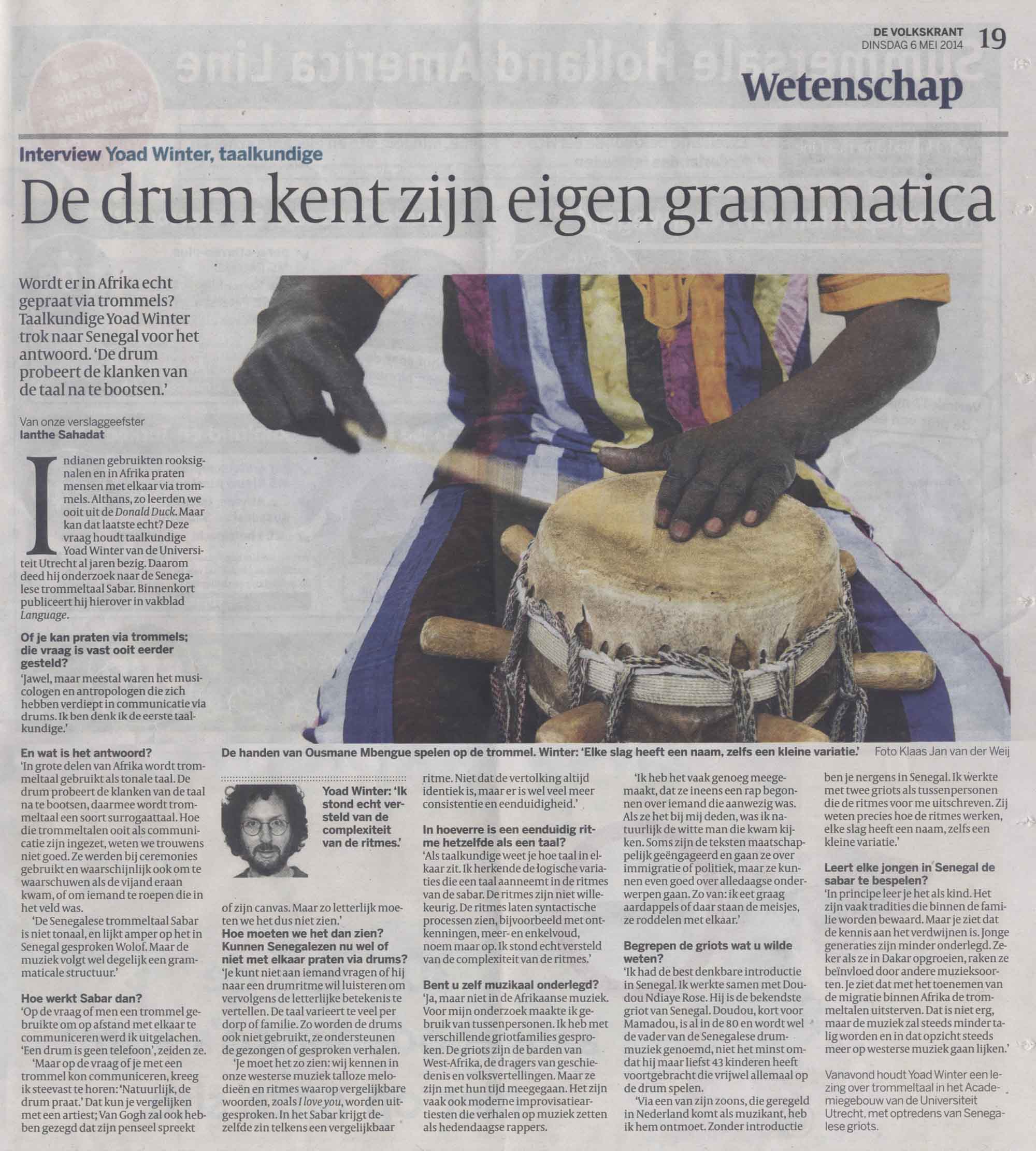

De Volkskrant, 6 May 2014, science section (p.19)
The drum has its own grammar
Interview with Yoad Winter,
linguist
By our correspondent
Ianthe Sahadat
Indians use smoke signals and in Africa people talk with each other
using drums. At any rate, this is what we once read in Donald Duck (a
popular Dutch weekly for children). But is it true? This question has kept
linguist Yoad Winter (Utrecht University) busy for years. That’s why he has
conducted a research about the Senegalese drum language, which is soon to be
published in the academic journal Language.
Can you use drums for talking: this question has surely been asked
before. Isn’t it?
`Sure, but it was usually musicologists and anthropologists who studied
drum communication. As far as I know, I’m the first linguist to study it.’
And what’s the answer?
`In many parts of Africa drums are used as a tonal language. The
drum tries to imitate the sounds of the language. In this way drum languages may
function as a sort of a speech surrogate. How precisely these drum were used
for communication we don’t know very well. They were used in ceremonies and
probably also to warn when an enemy came near, or to summon someone who was out
in the field.’
`The Sabar drum language of Senegal is not tonal, and is not quite
similar to the Wolof language spoken in Senegal. But the music does thoroughly
follow certain grammatical patterns.’
So how does Sabar work?
`When I posed the question if whether people use drums for
communicating with each other at a distance, I was often laughed at. `A drum is
not a telephone’, they would say.’
`But on the question on whether you can use the drum for
communication, I often heard: `Of course, the drum speaks’. You might compare it
with a painter: Van Gogh might also say that his paintbrush or canvas speaks. But
we shouldn’t take it so literally.’
How should we see it then? Can Senegalese people use drums for
talking or not?
`You can’t just go asking someone to listen to a rhythm and
tell you the meaning. The language changes too much between locations and
families. Furthermore, the drums are not used this way. They support spoken
stories and poems.’
`You can see it this way: we know in our Western music countless melodies and
rhythms that accompany words like I love you. In the Sabar drum language
the same sentence may each time get the same rhythm. It’s not that the
translation is always identical, but there is much more consistency and less
ambiguity.’
To what extent are unambiguous rhythms the same thing as a
language?
`As a linguist you know how language is organized. In the rhythms
of the sabar I recognized the logical variations that languages employ. The
rhythms are not arbitrary. They exhibit syntactic processes, for instance
negation, plurals and singulars, you name it. I was really amazed by the
complexity of the rhythms.’
Are you yourself musically literate?
`Not in African music. I used interpreters in this research. I
spoke with various griot families. The griots are the bards of West Africa, the
carriers of history and folk stories. But their traditions have been changing
over time. They often act as modern artists of literary improvisation who create
stories based on music, similarly to contemporary rappers.’
`I’ve quite often witnessed that they started a rap text about
somebody who was present. If it was me, then I was naturally the white man who
came watching. Sometimes the texts are socially engaged and concern immigration
and politics, but they may just as well be about common matters, such as: I
like to eat potatoes, or there go the girls, they gossip with each other.’
Did the griots understand what you were researching?
`I had the best thinkable introduction in Senegal. I worked
together with Doudou Ndiaye Rose. He is the most well-known griot
of Senegal. Doduou, a shortened form of Mamadou, is already in his 80s, and is
recognized as the father of Senegalese drum music, also because he has 43
children who are also professional drummers.’
`I met him through one of his sons who had come in the Netherlands as
a musician. Without introduction you don’t go very far in Senegal. I worked
with two griots who recognized the rhythms for me. They know precisely how the
rhythms work, each drum stroke has a name, even the smallest variation.’
Does every Senegalese child learn to play the sabar?
`In principle, griots learn it as children. These are often
traditions kept within the family. But you often see that the knowledge [of the
drum language] starts to disappear. The young generations are less accomplished
[in it]. Certainly if they grow in Dakar they are influenced by other sorts of
music. Together with the increase of emigration within Africa, the drum
languages get endangered. This is not terrible but the music is becoming less
language-like, and in that sense more similar to music in the Western world.’